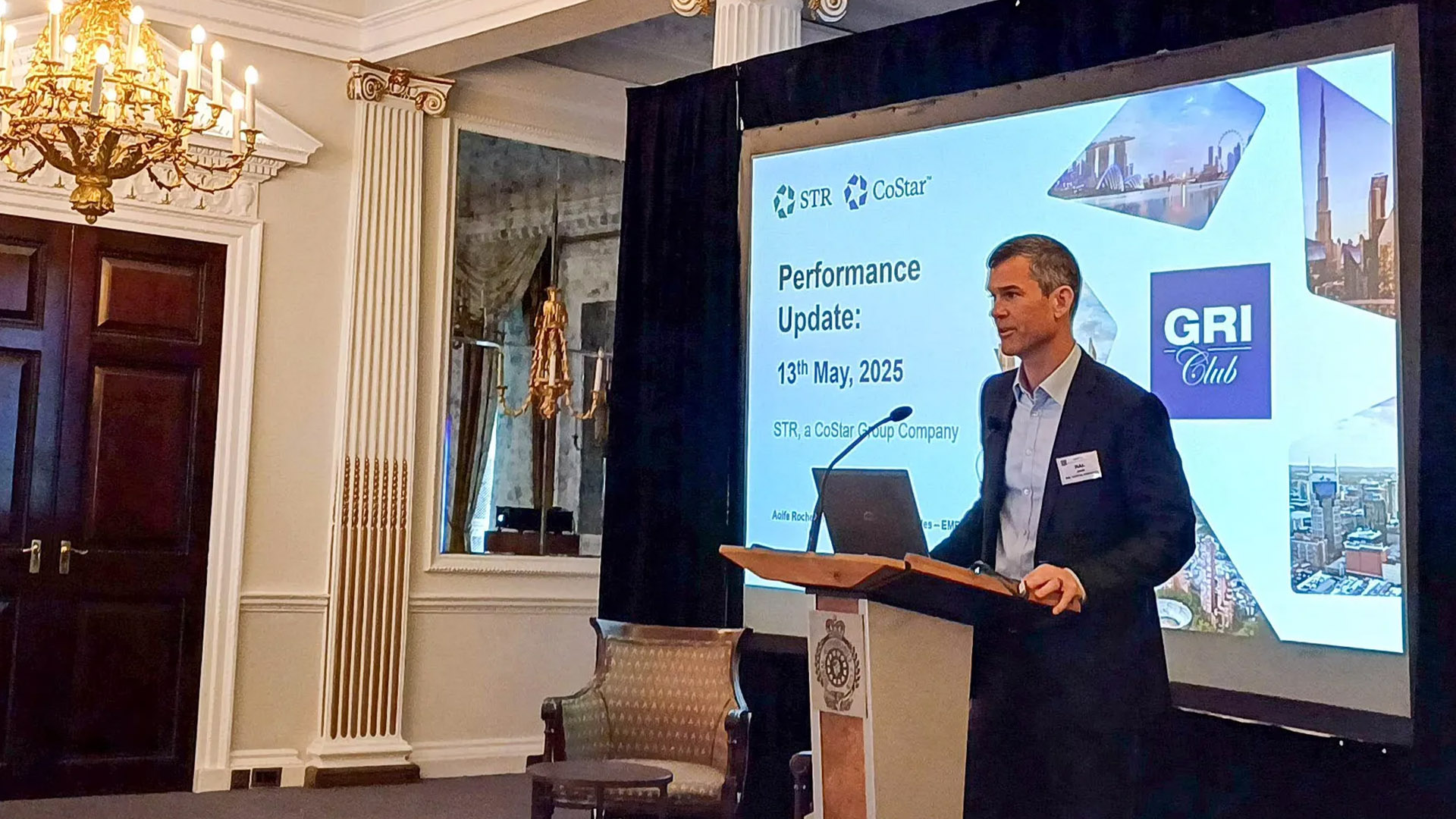 Credit: GRI Club
Credit: GRI ClubInternational Hotel Investments: Navigating Recovery and Emerging Risks
Top UK and international hospitality leader insights on shifting hospitality trends, new investment flows, and asset strategies
May 28, 2025Real Estate
Written by Rory Hickman
At our recent Hotel Investments Club Meeting in London, leading UK and international hotel investors, asset owners, operators, and lenders convened to dissect the current market outlook, pricing trends, and structural shifts impacting investment decisions in hospitality real estate.
The gathering offered a candid exchange of views on everything from luxury to budget hospitality, revealing a market navigating short-term uncertainties with a cautiously optimistic eye on medium-term opportunities.
Two weeks prior to the meeting, sentiment among investors was tinged with panic amid market turbulence. However, fresh data brought a more balanced perspective, instilling modest confidence in the industry’s ability to navigate ongoing challenges.
Notably, overseas arrivals to the US rebounded in March 2025, following a weak February, although the anticipated full recovery of international travel to the US has been pushed back from 2027 to 2029, prolonging uncertainty.
Inbound travel from Western Europe to the US declined sharply, with the UK and Germany accounting for half of this drop, representing around 350,000 fewer travellers. This decline appears linked to earlier travel advisories and persistent geopolitical tensions, reflecting how political events continue to influence travel demand.
Meanwhile, India’s rising middle class presents a significant opportunity, though the integration of its legacy hospitality brands into global systems remains a challenge, signalling a period of transition for the market.

While private equity and institutional investors in core and core-plus segments remain slower to follow, early signals suggest the trend is gaining momentum.
Potential punitive tariffs from the US, such as a hypothetical 25% withholding tax, combined with negative domestic media framing, create both political and reputational risks that temper enthusiasm - a dynamic that is emblematic of broader investor caution amid increasing US political unpredictability.
Lease structures post-pandemic have become highly variable - in some portfolios, variable rent constitutes up to 40% of total rent, while others generate none. This bifurcation means investors must navigate between fully bearing operational risk and long leases with uncertain recovery, complicating underwriting and investment strategies.
Another critical discussion point centred on the risks of over-relying on short-term revenue per available room (RevPAR) models, with industry leaders warning that precision in near-term forecasting might mask a wide dispersion of possible macroeconomic scenarios, including geopolitical shocks or financial upheavals.

In London, a concentration of about 10 ultra-luxury hotels chasing a similar niche presents both opportunity and saturation risk, with established luxury hotels in prime locations such as Knightsbridge and Hyde Park Corner responding by lowering rates, intensifying competition for new entrants.
Meanwhile, mid-tier and upscale hotels experienced a robust recovery through 2023 and 2024, fuelled by the return of group travel and more diverse international demand.
Growth from emerging source markets such as India and China is expected to bolster demand in these segments. However, unpredictability in booking behaviour is driving more last-minute travel, complicating operational forecasting.
Student demand benefits from curriculum-mandated travel, providing a resilient and predictable base.
To keep up with demand, older, CapEx-intensive budget hotels are being converted into hostels to unlock higher per-square-foot revenue by increasing room density and repurposing underused meeting spaces.
For those participating in the hospitality real estate sector, the message is clear: success will depend on understanding the interplay of geopolitical shifts, travel behaviour evolution, and innovative asset management approaches.
At our recent Hotel Investments Club Meeting in London, leading UK and international hotel investors, asset owners, operators, and lenders convened to dissect the current market outlook, pricing trends, and structural shifts impacting investment decisions in hospitality real estate.
The gathering offered a candid exchange of views on everything from luxury to budget hospitality, revealing a market navigating short-term uncertainties with a cautiously optimistic eye on medium-term opportunities.
Navigating volatility towards stability
The global hospitality investment landscape remains a dynamic and evolving sector, shaped by shifting travel patterns, capital flows, and emerging asset strategies.Two weeks prior to the meeting, sentiment among investors was tinged with panic amid market turbulence. However, fresh data brought a more balanced perspective, instilling modest confidence in the industry’s ability to navigate ongoing challenges.
Notably, overseas arrivals to the US rebounded in March 2025, following a weak February, although the anticipated full recovery of international travel to the US has been pushed back from 2027 to 2029, prolonging uncertainty.
Inbound travel from Western Europe to the US declined sharply, with the UK and Germany accounting for half of this drop, representing around 350,000 fewer travellers. This decline appears linked to earlier travel advisories and persistent geopolitical tensions, reflecting how political events continue to influence travel demand.
Meanwhile, India’s rising middle class presents a significant opportunity, though the integration of its legacy hospitality brands into global systems remains a challenge, signalling a period of transition for the market.

(GRI Club)
International Investment Flows
Capital is visibly shifting away from the US towards European public markets, notably within the Eurozone, Switzerland, and the UK.While private equity and institutional investors in core and core-plus segments remain slower to follow, early signals suggest the trend is gaining momentum.
Potential punitive tariffs from the US, such as a hypothetical 25% withholding tax, combined with negative domestic media framing, create both political and reputational risks that temper enthusiasm - a dynamic that is emblematic of broader investor caution amid increasing US political unpredictability.
Shifting hospitality trends
Institutional investors, especially from Germany, are increasingly favouring direct involvement in hotel real estate, even in markets historically dominated by lease arrangements. This shift aims to maintain operational control without micromanaging.Lease structures post-pandemic have become highly variable - in some portfolios, variable rent constitutes up to 40% of total rent, while others generate none. This bifurcation means investors must navigate between fully bearing operational risk and long leases with uncertain recovery, complicating underwriting and investment strategies.
Another critical discussion point centred on the risks of over-relying on short-term revenue per available room (RevPAR) models, with industry leaders warning that precision in near-term forecasting might mask a wide dispersion of possible macroeconomic scenarios, including geopolitical shocks or financial upheavals.

(GRI Club)
Divergent segment performance
When it came to the performance of different hospitality assets, it was observed that the ultra-luxury hotel sector remains resilient, driven by an ultra-high-net-worth clientele largely insulated from economic headwinds such as inflation and stock market volatility.In London, a concentration of about 10 ultra-luxury hotels chasing a similar niche presents both opportunity and saturation risk, with established luxury hotels in prime locations such as Knightsbridge and Hyde Park Corner responding by lowering rates, intensifying competition for new entrants.
Meanwhile, mid-tier and upscale hotels experienced a robust recovery through 2023 and 2024, fuelled by the return of group travel and more diverse international demand.
Growth from emerging source markets such as India and China is expected to bolster demand in these segments. However, unpredictability in booking behaviour is driving more last-minute travel, complicating operational forecasting.
European hostel growth
Representatives from the European hostel sector detailed a portfolio encompassing over 30,000 beds across 40 properties, generating approximately 7.5 million overnight stays annually, with 2.5 million attributed to student travellers.Student demand benefits from curriculum-mandated travel, providing a resilient and predictable base.
To keep up with demand, older, CapEx-intensive budget hotels are being converted into hostels to unlock higher per-square-foot revenue by increasing room density and repurposing underused meeting spaces.
Looking Ahead
Discussions at the meeting highlighted a market in flux as it struggles to balance short-term uncertainties with long-term structural opportunities. With evolving capital flows, new asset strategies, and a diverse traveller profile, investors must adapt with agility and nuance.For those participating in the hospitality real estate sector, the message is clear: success will depend on understanding the interplay of geopolitical shifts, travel behaviour evolution, and innovative asset management approaches.